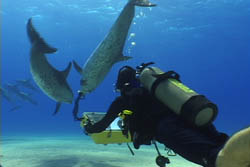
BlueVoice Press Release for IWC 2011
Contact: Hardy Jones – hardyjones@bluevoice.org
During the IWC: Hotel de France +44 1534 614000
NEW DISCOVERIES IN WHALE INTELLIGENCE
The official opinion posted on the Japan Whaling Association website is that whales are no more intelligent or special than cows. That is beyond a falsehood. It is an absurdity; but an absurdity based on self-interest.
THE TRUTH: Whales are now documented to share the same kind of intelligence possessed by humans, according to researchers after discovering brain cells in humpback whales previously found only in humans, other primates and elephants.(4)
Recent studies have found a certain type of neuron cell in humpback whales thought to be involved in higher mental processes. These brain structures were previously believed to be the thing that made humans unique in the animal kingdom based on the fact that they’re involved with the processes of emotion and social interaction. These cells occur in parts of the human brain thought to be responsible for social organization, empathy, speech, and intuition about the feelings of others.
These so-called spindle cells are credited with allowing us to feel love and to suffer emotionally. To repeat, they were touted as the brain cells that set humans and the other great apes apart from all other mammals with the possible exception of elephants. Now it has been discovered that several species of whale also have spindle neurons.
Humpbacks, other whales and dolphins exhibit complex social patterns that include intricate communication skills, coalition-formation, cooperation and cultural transmission of information.
The cells, known as spindle neurons, are found in two very restricted regions in the brains of hominids - the family of species comprising humans and other great apes – the anterior cingulated cortex (ACC) and the fronto-insular cortex (FI). Recently they have been discovered in the dorsolateral prefrontal cortex of human as well.(1) Spindle cells are also found in the brains of humpback whales, fin whales, killer whales, sperm whales(2)(3), bottlenose dolphins, Risso’s dolphins, beluga whales, and African and Asian Elephants(5).
These discoveries raise profound questions on the ethics of hunting such sentient creatures.
Examples Of Culture In Whales(6)
Within a given humpback population, male whales (only the males sing) adopt the same mating song, with only minor variations. These songs can be enormously complex, made up of numerous themes that are repeated in the same order. From 1998 to 2008, the researchers identified 11 distinct songs.
“Humpback whale song is unique because intense conformism to the current (song) norm is coupled with high plasticity in the trait,” the authors write.
Male humpback whales (Megaptera novaeangliae) have a highly stereotyped, repetitive, and progressively evolving vocal sexual display or “song” that functions in sexual selection (through mate attraction and/or male social sorting). All males within a population conform to the current version of the display (song type), and similarities may exist among the songs of populations within an ocean basin. Here we present a striking pattern of horizontal transmission: multiple song types spread rapidly and repeatedly in a unidirectional manner, like cultural ripples, eastward through the populations in the western and central South Pacific over an 11-year period. This is the first documentation of a repeated, dynamic cultural change occurring across multiple populations at such a large geographic scale.
The information in this paper is drawn from the sources cited below and is used under The Fair Use Act.
(1) Fajardo et. al.; Escobar, M.I.; Buriticá, E.; Arteaga, G.; Umbarila, J.; Casanova, M.F.; Pimienta, H. (4 March 2008). "Von Economo neurons are present in the dorsolateral (dysgranular) prefrontal cortex of humans." Neuroscience Letters 435 (3): 215–218
(2) Coghlan, A. (27 November 2006). “Whales boast the brain cells that make us human.” New Scientist.
(3) Hof, P. R., Van der Gucht, E. (Jan 2007). "Structure of the cerebral cortex of the humpback whale, Megaptera novaeangliae (Cetacea, Mysticeti, Balaenopteridae)". Anat Rec (Hoboken) 290 (1): 1–31.
(4)Butti C, Sherwood CC, Hakeem AY, Allman JM, Hof PR (July 2009). "Total number and volume of Von Economo neurons in the cerebral cortex of cetaceans.". The Journal of comparative neurology 515 (2): 243–59. (5) Hakeem, A. Y.; Sherwood, C. C.; Bonar, C. J.; Butti, C.; Hof, P. R.; Allman, J. M. (2009). "Von Economo neurons in the elephant brain". The Anatomical Record (Hoboken) 292 (2): 242–8. (6)Dynamic Horizontal Cultural Transmission of Humpback Whale Song at the Ocean Basin Scale,Ellen C. Garland, Michael J. Noad, Anne W. Goldizen, and seven other authors, Current Biology (April 26, 2011)
General References
Nimchinsky EA, Gilissen E, Allman JM, Perl DP, Erwin JM, Hof PR (Apr 1999). “A neuronal morphologic type unique to humans and great apes. Proc Natl Acad Sci USA. 96 (9): 5268–73.
Allman J, Hakeem A, Watson K (Aug 2002). “Two phylogenic specializations in the human brain. Neuroscientist 8 (4): 335–46.


No comments:
Post a Comment